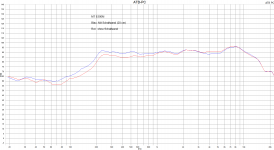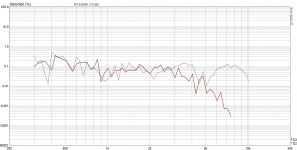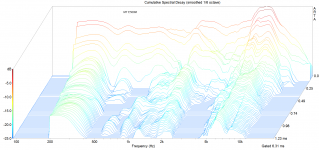TD15H - 8ohm
Fs: 21.0Hz
Qms:4.23
Vas: 467L
Cms: .45mm/N
Mms: 129g
Rms: 4kg/s
Xmax: 14mm
Sd: 855
Qes: .27
Re: 6.5ohm
Le: .3mH
Z: 8ohm
Bl: 20.1Tm
Pe(cont): 500W
Qts: .26
1W SPL: 94.0dB
TD15M - 8ohm
Fs: 34.7Hz
Qms: 5.09
Vas: 312L
Cms: .3mm/N
Mms: 70g
Rms: 3kg/s
Xmax: 6mm
Sd: 855
Qes: .35
Re: 6.6
Le: .2mH
Z: 8ohm
Bl: 17Tm
Pe: 500W
Qts: .33
1W SPL: 97.8dB
TD15H has lower fs, higher Xmax, lower Qts but lower sensitivity TD15M.
Perfect for actively driven OB elements where control was my key requirement as the excursion will be high for the dipole roll off compensation (6 dB/octave).
The Apollo option adds two additional massive aluminum shorting rings.
This further linearizes inductance and greatly adds to the heatsinking ability of the driver for high power usage.
There are more information at AE´s site.
Fs: 21.0Hz
Qms:4.23
Vas: 467L
Cms: .45mm/N
Mms: 129g
Rms: 4kg/s
Xmax: 14mm
Sd: 855
Qes: .27
Re: 6.5ohm
Le: .3mH
Z: 8ohm
Bl: 20.1Tm
Pe(cont): 500W
Qts: .26
1W SPL: 94.0dB
TD15M - 8ohm
Fs: 34.7Hz
Qms: 5.09
Vas: 312L
Cms: .3mm/N
Mms: 70g
Rms: 3kg/s
Xmax: 6mm
Sd: 855
Qes: .35
Re: 6.6
Le: .2mH
Z: 8ohm
Bl: 17Tm
Pe: 500W
Qts: .33
1W SPL: 97.8dB
TD15H has lower fs, higher Xmax, lower Qts but lower sensitivity TD15M.
Perfect for actively driven OB elements where control was my key requirement as the excursion will be high for the dipole roll off compensation (6 dB/octave).
The Apollo option adds two additional massive aluminum shorting rings.
This further linearizes inductance and greatly adds to the heatsinking ability of the driver for high power usage.
There are more information at AE´s site.
So if I plan on using the driver between ~150-200Hz and up to where the tweeter will take over it is better if I go with the M version I suppose? I will use the TD18H+ or something similar for sub-150.
Would the Apollo upgrade improve the midrange significantly? I don't think I would ever feed them with more than maybe 200-300 watts so would I really need extra heatsinking ability?
Would the Apollo upgrade improve the midrange significantly? I don't think I would ever feed them with more than maybe 200-300 watts so would I really need extra heatsinking ability?
The Apollo upgrade isn´t directly involved in the frequency response but the phase plug is.
Some information about the motor.
Some information about the motor.
What is the sensitivity of the AMTs?
Hi,
First of all: I'm very impressed by the your work developing these great looking AMTs!
What is the approximate sensitivity of these beasts?
Thanks!
Best regards
Peter
Hi,
First of all: I'm very impressed by the your work developing these great looking AMTs!
What is the approximate sensitivity of these beasts?
Thanks!
Best regards
Peter
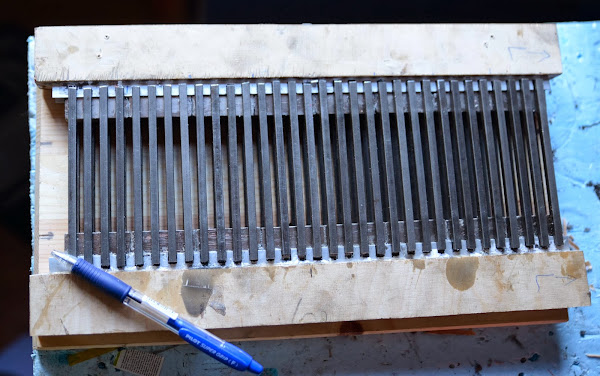
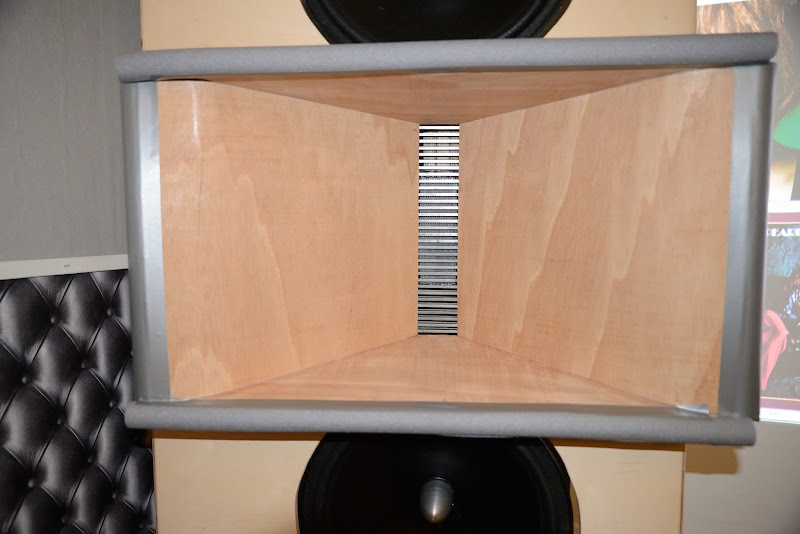
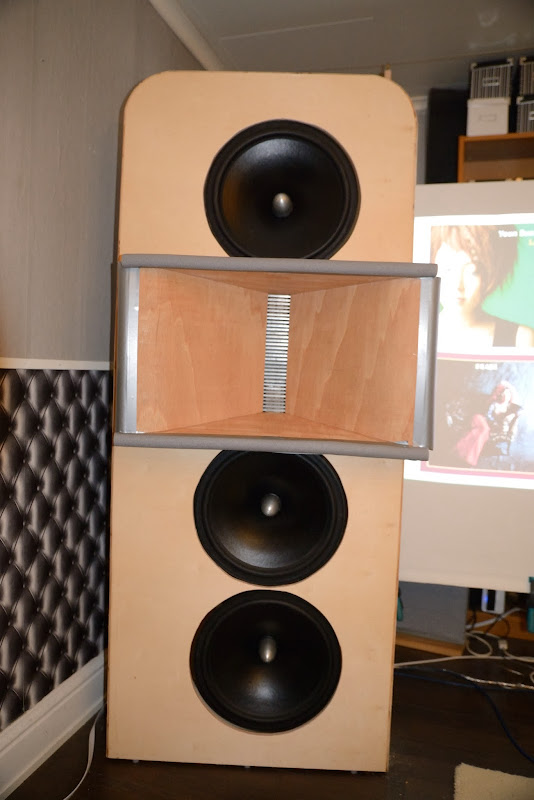
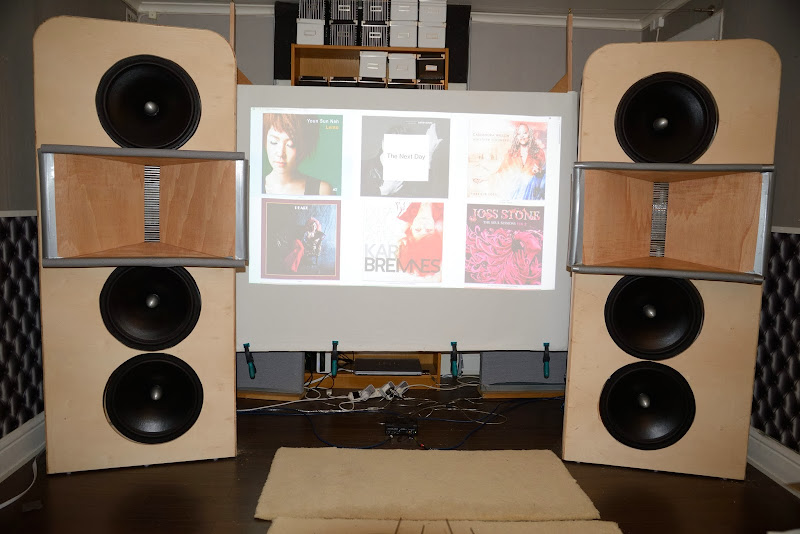
Still have to do new membranes to the new motor as it is somewhat wider and double the height of the old one.
I plan to have two membranes in series for each motor.
Thanks a lot!
Do you have any idea about the power handling of the amt driver?
Have you had a chance to compare your amt driver to any of the commercialy available products (e.g. the Beyma TPL-150H)?
Best regards
Peter
Do you have any idea about the power handling of the amt driver?
Have you had a chance to compare your amt driver to any of the commercialy available products (e.g. the Beyma TPL-150H)?
Best regards
Peter
I reckon the sensitivity will be between 91 and 95 dB with the waveguide.
Attachments
Those are very interesting questions, Peter.
I'm driving the AMTs with one 25 W class A amplifier each (The Trimodal from Douglas Self), so I guess that the AMTs can handle that amount of power.
But I haven't put them to an actual test yet.
(The TDs have one Gainclone @ 45 W each BTW.)
It is not until the latest AMTs I have built that they resembles the TPL-150H, so it would for sure be interesting to make comparisions.
Perhaps RayCtech has done some.
Anyway, any comparision would be unfair since I run mine as dipoles and also use some active EQ.
I'm driving the AMTs with one 25 W class A amplifier each (The Trimodal from Douglas Self), so I guess that the AMTs can handle that amount of power.
But I haven't put them to an actual test yet.
(The TDs have one Gainclone @ 45 W each BTW.)
It is not until the latest AMTs I have built that they resembles the TPL-150H, so it would for sure be interesting to make comparisions.
Perhaps RayCtech has done some.
Anyway, any comparision would be unfair since I run mine as dipoles and also use some active EQ.
Hi,
Thanks for responding!
I ask, because I am a happy owner of a pair of Beyma TPL-150H. The Beyma sounds much more natural than any of the compression drivers I have used so far (no more sibilance and over-pronounced s- and t-sounds on female voices!). However, as you probably already know, the Beyma cannot be used below, say, 1300-1400 Hz (and that may even be a stretch), and I would really like to take the clarity, resolution, and "speed" from the Beyma AMT further down in frequency - just like you have manached to do!
The power handling and efficiency of the Beyma is quite impressive too, though, and may be hard to replicate.
I wish I had your skills
Best regards
Peter
Thanks for responding!
I ask, because I am a happy owner of a pair of Beyma TPL-150H. The Beyma sounds much more natural than any of the compression drivers I have used so far (no more sibilance and over-pronounced s- and t-sounds on female voices!). However, as you probably already know, the Beyma cannot be used below, say, 1300-1400 Hz (and that may even be a stretch), and I would really like to take the clarity, resolution, and "speed" from the Beyma AMT further down in frequency - just like you have manached to do!
The power handling and efficiency of the Beyma is quite impressive too, though, and may be hard to replicate.
I wish I had your skills
Best regards
Peter
Those are very interesting questions, Peter.
I'm driving the AMTs with one 25 W class A amplifier each (The Trimodal from Douglas Self), so I guess that the AMTs can handle that amount of power.
But I haven't put them to an actual test yet.
(The TDs have one Gainclone @ 45 W each BTW.)
It is not until the latest AMTs I have built that they resembles the TPL-150H, so it would for sure be interesting to make comparisions.
Perhaps RayCtech has done some.
Anyway, any comparision would be unfair since I run mine as dipoles and also use some active EQ.
Compression driver Sss and Tsss-sounds can be fixed with a smooth supertweeter.
My ranking from 8kHz up:
1. Transmission Audio true ribbon (and probably also RAAL)
2. TPL-150
3. Compression drivers/Dome tweeters
Below that, compression drivers all the way down to 350Hz, where cone drivers pick up.
I do enjoy the TPL-150 as it sounds completely different and rather clean. I only wish it would go deeper, because the TPL-150 is beaten by true ribbons above ~8kHz, but to use it between 2kHz-8kHz is just stupid. Some day when I feel I have mastered the horns, I will attempt the midrange AMT, because it seems like a really good idea. Horns are just much more fun right now.
My ranking from 8kHz up:
1. Transmission Audio true ribbon (and probably also RAAL)
2. TPL-150
3. Compression drivers/Dome tweeters
Below that, compression drivers all the way down to 350Hz, where cone drivers pick up.
I do enjoy the TPL-150 as it sounds completely different and rather clean. I only wish it would go deeper, because the TPL-150 is beaten by true ribbons above ~8kHz, but to use it between 2kHz-8kHz is just stupid. Some day when I feel I have mastered the horns, I will attempt the midrange AMT, because it seems like a really good idea. Horns are just much more fun right now.
Hi Rewind,
It is not my experience that sibilance can be cured by adding a super tweeter - at least not with the compression drivers, I have tried. When I used the 2" BMS 4592ND, I had much trouble with sibilance. I then tried to drop the tweeter section of the BMS and used the very nice (now obsolete) Fostex T850 as super tweeter above 6k. It sure helped, but it did not remove the problem.
I then tried the Community M200 as mid driver. It sounded more open and relaxed than the BMS; sibilance was reduced, but not gone. Moving on to the Beyma TPL it only took a few seconds to realize that it was a clear improvement with regards to natural sounding voices compared to the aforementioned compression drivers. Your mileage may vary, of course
Best regards
Peter
It is not my experience that sibilance can be cured by adding a super tweeter - at least not with the compression drivers, I have tried. When I used the 2" BMS 4592ND, I had much trouble with sibilance. I then tried to drop the tweeter section of the BMS and used the very nice (now obsolete) Fostex T850 as super tweeter above 6k. It sure helped, but it did not remove the problem.
I then tried the Community M200 as mid driver. It sounded more open and relaxed than the BMS; sibilance was reduced, but not gone. Moving on to the Beyma TPL it only took a few seconds to realize that it was a clear improvement with regards to natural sounding voices compared to the aforementioned compression drivers. Your mileage may vary, of course
Best regards
Peter
Compression driver Sss and Tsss-sounds can be fixed with a smooth supertweeter.
My ranking from 8kHz up:
1. Transmission Audio true ribbon (and probably also RAAL)
2. TPL-150
3. Compression drivers/Dome tweeters
Below that, compression drivers all the way down to 350Hz, where cone drivers pick up.
I do enjoy the TPL-150 as it sounds completely different and rather clean. I only wish it would go deeper, because the TPL-150 is beaten by true ribbons above ~8kHz, but to use it between 2kHz-8kHz is just stupid. Some day when I feel I have mastered the horns, I will attempt the midrange AMT, because it seems like a really good idea. Horns are just much more fun right now.
The Fostex T850 is still sort of a compression driver. Try a ribbon instead.
The Community M200 is a nice driver, but it is missing a phase plug, which would help it above ~3kHz. It has an open feeling to it, and you can achieve this open feeling by turning any similar compression driver backwards and remove the back chamber. I tried it. But I preferred the drivers with phase plug, because then I can use 2nd order crossovers.
I tried it. But I preferred the drivers with phase plug, because then I can use 2nd order crossovers.
Compression drivers and the TPL-150 is just two very different things, and I don't think you can combine them both if you aim to run the TPL-150 down to 2kHz.
The Community M200 is a nice driver, but it is missing a phase plug, which would help it above ~3kHz. It has an open feeling to it, and you can achieve this open feeling by turning any similar compression driver backwards and remove the back chamber.
Compression drivers and the TPL-150 is just two very different things, and I don't think you can combine them both if you aim to run the TPL-150 down to 2kHz.
But the Fostex T850 wasn't the problem; the Fostex is an excellent super tweeter. It was the 2" compression drivers in the 1-6kHz frequency range, that I could not stand. I'm not using compression drivers any more, and that is why I'm interested in the excellent work of Solhaga!
Best regards
Peter
Best regards
Peter
The Fostex T850 is still sort of a compression driver. Try a ribbon instead.
The Community M200 is a nice driver, but it is missing a phase plug, which would help it above ~3kHz. It has an open feeling to it, and you can achieve this open feeling by turning any similar compression driver backwards and remove the back chamber.I tried it. But I preferred the drivers with phase plug, because then I can use 2nd order crossovers.
Compression drivers and the TPL-150 is just two very different things, and I don't think you can combine them both if you aim to run the TPL-150 down to 2kHz.
Bernd from BelAMT is developing a air motion, that plays down to 200hz flat. Its a commercial offering, but i am unsure, when they will become available to the public.
Angelo
Angelo
Attachments
I wish I had your skills
that is why I'm interested in the excellent work of Solhaga
båndsei is the real hero! I´m just copying his work
 .
.Sorry, forgot my rhetoric skills  .
.
I´ve only done a first test to see if it can cut alu/paper at all.
And it can.
Problem is to get a good supporting material for the alu/paper as it is not rigid enough for the conveyer.
The cutting mat that was included was too sticky and I had a hard time removing the alu/paper.
The best way to do it is probably to have a heavier paper and spray adhesive on that and then glue the alu/paper with the paper down.
Do the cutting and then apply the mylar. Then the paper and the paper from the alu/paper has to be dissolved.
Perhaps it is better then to use the 7 um alu/paper as that paper comes off more easily just using water; you don´t need to peel it off manually as you would have to with the 10 um alu/paper from Vita.
 .
.I´ve only done a first test to see if it can cut alu/paper at all.
And it can.
Problem is to get a good supporting material for the alu/paper as it is not rigid enough for the conveyer.
The cutting mat that was included was too sticky and I had a hard time removing the alu/paper.
The best way to do it is probably to have a heavier paper and spray adhesive on that and then glue the alu/paper with the paper down.
Do the cutting and then apply the mylar. Then the paper and the paper from the alu/paper has to be dissolved.
Perhaps it is better then to use the 7 um alu/paper as that paper comes off more easily just using water; you don´t need to peel it off manually as you would have to with the 10 um alu/paper from Vita.
- Status
- This old topic is closed. If you want to reopen this topic, contact a moderator using the "Report Post" button.
- Home
- Loudspeakers
- Planars & Exotics
- Yet another DIY AMT
